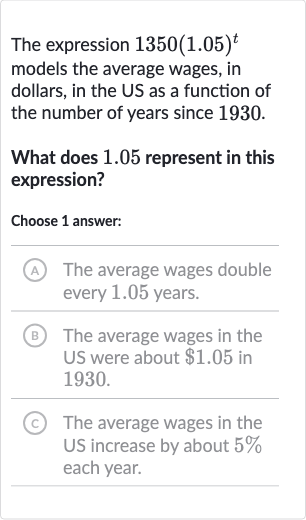AI tutor
Welcome to Bytelearn!
Let’s check out your problem:

The expression models the average wages, in dollars, in the US as a function of the number of years since .What does represent in this expression?Choose answer:(A) The average wages double every years.(B) The average wages in the US were about in .(C) The average wages in the US increase by about each year.
Full solution
Q. The expression models the average wages, in dollars, in the US as a function of the number of years since .What does represent in this expression?Choose answer:(A) The average wages double every years.(B) The average wages in the US were about in .(C) The average wages in the US increase by about each year.
- Structure of Expression: The expression given is , which models the average wages in the US as a function of time since . To understand what represents, we need to look at the structure of the expression. It is an exponential function where is the base raised to the power of , which represents time in years. In the context of growth, the base of an exponential function (greater than ) indicates the growth factor per unit of time.
- Interpretation of Base: Since the base is , this suggests that for each year , the average wages are multiplied by . This multiplication by is equivalent to a increase each year because is of the previous year's wages plus an additional .
- Evaluation of Choices: Now, let's evaluate the choices given:(A) The average wages double every years. - This is incorrect because the expression does not imply doubling; it implies a steady growth rate.(B) The average wages in the US were about in . - This is incorrect because the in the expression likely represents the initial average wages in , not .(C) The average wages in the US increase by about each year. - This is correct because the base of the exponential function, , indicates a increase.
More problems from Interpreting Linear Expressions
QuestionGet tutor help
